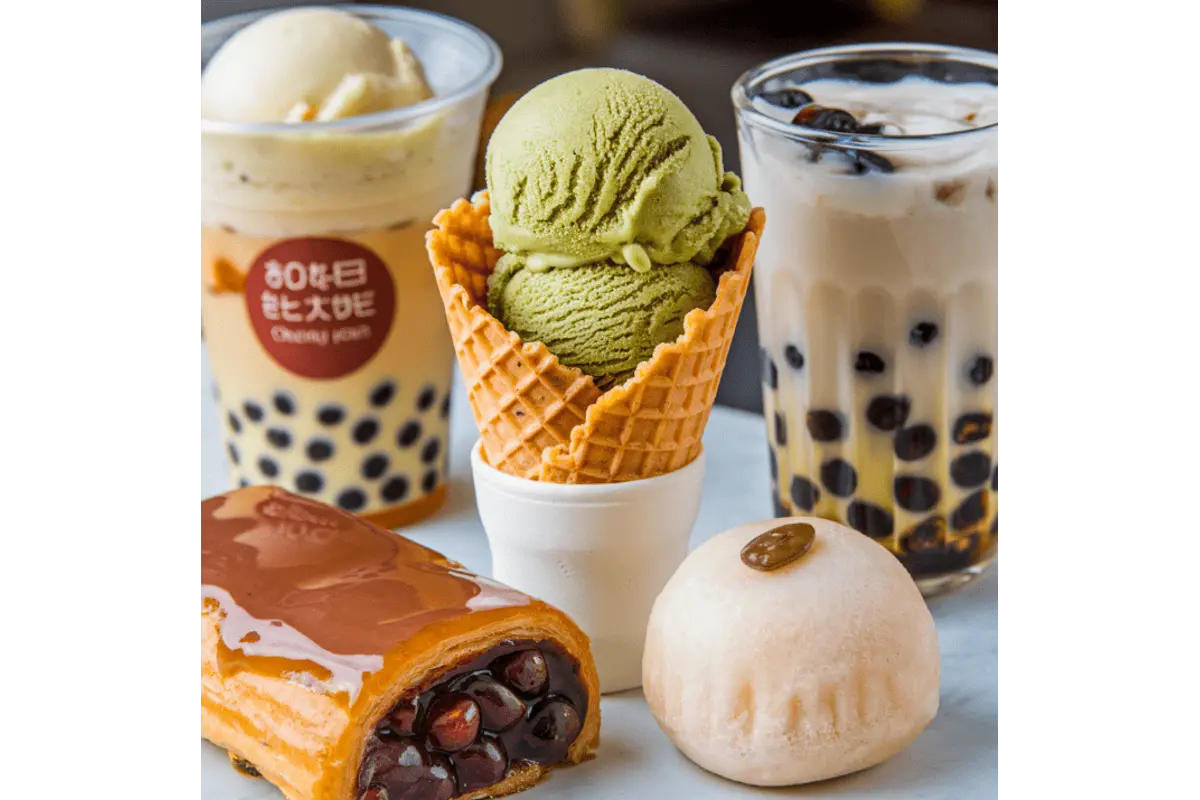Asian cuisine is famous for its bold, vibrant flavors. Its desserts stand out with their unique textures and rich cultural history. From the chewy mochi to creamy mango sticky rice, these treats bring something fresh and exciting to the table. Each dessert tells a story, blending tradition and creativity in every bite. Whether you’re a dessert lover or someone exploring new flavors, Asian desserts offer an unforgettable culinary adventure.
Understanding Asian desserts requires looking at the ingredients, preparation methods, and their cultural significance. Many of these treats rely on natural sweetness and earthy flavors, setting them apart from sugar-heavy Western desserts.
Table of Contents
What Makes Asian Desserts Unique?
The Distinct Charm of Asian Desserts
Asian desserts are known for their natural ingredients and creative techniques. Unlike Western sweets, which often use butter and refined sugar, these treats feature items like glutinous rice flour, coconut milk, and tropical fruits. These ingredients create textures and flavors that are light, refreshing, and satisfying. For example, tangyuan (glutinous rice balls) offer a chewy texture, while halo-halo combines creamy, icy, and crunchy layers in one dessert. Curious about chinese pastries, check this link.
Many Asian desserts are tied to cultural celebrations and family traditions. Tangyuan, for instance, is eaten during the Lantern Festival to symbolize unity and togetherness. Desserts like these go beyond taste—they connect people to their heritage. The global rise of Asian bakeries and restaurants has made these desserts more accessible than ever.
Why Explore Asian Desserts?
Exciting Flavors
Ingredients like pandan and ube are not only integral to the distinct and memorable flavors of many Asian desserts, but they also bring a unique sense of indulgence and comfort. For example, pandan, often referred to as the “vanilla of Southeast Asia,” delivers a sweet, nutty aroma that pairs beautifully with creamy bases such as coconut milk. Furthermore, ube, the Filipino purple yam, combines a nutty and subtly sweet flavor with a vibrant purple hue, making it both delicious and visually stunning. In addition, these ingredients provide versatility, allowing them to enhance a variety of recipes, ranging from traditional puddings to modern fusion pastries. As a result, they do not just create bold tastes—they evoke a comforting familiarity that appeals to people of all ages.
Cultural Significance
Many Asian desserts carry deep symbolic meanings that go far beyond mere indulgence. For instance, tangyuan, or glutinous rice balls, are enjoyed during the Lantern Festival because they symbolize family unity and harmony. Similarly, desserts like halo-halo in the Philippines celebrate diversity through their colorful and layered ingredients, which, in turn, reflect the nation’s rich cultural mix. Additionally, Indian sweets such as gulab jamun are staples at weddings and festivals, representing prosperity and joy. Therefore, by enjoying these desserts, you are not only satisfying your sweet tooth but also participating in a tradition that honors celebration, gratitude, and love. Consequently, every bite offers a deeper connection to the culture it represents.
Healthier Choices
Unlike many Western desserts, Asian desserts often emphasize natural sweetness and light textures, making them a great alternative for health-conscious individuals. For instance, sweeteners like palm sugar and jaggery not only reduce reliance on refined sugar but also add a richer, more complex flavor profile. Moreover, many recipes use plant-based thickeners, such as agar-agar, which create lighter desserts without compromising on indulgence. For example, che ba mau blends the richness of coconut milk with the refreshing flavors of mung bean and pandan jelly, resulting in a dessert that satisfies cravings without being overly heavy. As a result, these desserts strike a perfect balance between indulgence and mindfulness, offering options that are both flavorful and health-conscious.
Global Appeal
With the rise of Asian bakeries and restaurants worldwide, it has become much easier to experience the magic of Asian desserts. For instance, you can now find mochi ice cream in many local grocery stores, while intricately crafted taiyaki is available in bustling food markets. Furthermore, the growing availability of ingredients like matcha, ube, and pandan leaves in global supermarkets and online stores has made it significantly simpler to recreate these desserts at home. Consequently, this global appeal showcases the universal love for Asian desserts, as their accessibility allows anyone to explore these sweet creations. As a result, more people are discovering the joy of Asian flavors, connecting cultures through shared culinary experiences.
Expanding Horizons
Exploring Asian desserts is not just about enjoying new flavors—it’s also about diving into the stories, traditions, and creativity behind them. Each dessert reflects the region’s history and innovation, blending ancient techniques with modern twists. Moreover, these desserts often challenge preconceived notions about what desserts should taste like, offering surprising textures and unique ingredient combinations. By trying these desserts, you open your palate to a world of textures, flavors, and culinary artistry that bridges the gap between tradition and innovation. Ultimately, the result is an enriching experience that not only satisfies your curiosity but also brings you closer to the culture and creativity that shape these delicious treats
Ingredients That Define Asian Desserts
Sweeteners and Thickeners
Asian desserts rely on natural sweeteners to bring depth and balance to their flavors. Palm sugar, jaggery, and honey are popular choices. These sweeteners are less refined than white sugar and offer earthy tones that enhance the dessert’s complexity. For example, gulab jamun uses cardamom-scented syrup, while che ba mau gets its sweet profile from coconut milk.
Thickeners play a key role in achieving signature textures. Tapioca starch creates soft, bouncy consistencies in puddings. Glutinous rice flour gives mochi and tangyuan their chewy feel. Agar-agar, a plant-based gelatin alternative, is used in jellied desserts like three-color che. These ingredients create textures that are hard to replicate with Western methods. Organize your ingredients with meal prep containers.
Flavors That Stand Out
Asian desserts showcase bold and distinctive flavors. Each region uses unique ingredients to create unforgettable taste experiences.
- Pandan: This tropical leaf adds a grassy aroma and vibrant green color to desserts like pandan chiffon cake.
- Ube: Known as purple yam, ube adds nutty sweetness and striking color to dishes like ube halaya and ice cream.
- Matcha: Japanese green tea powder offers a slightly bitter yet creamy flavor in treats like matcha cheesecake.
These ingredients create desserts that look as good as they taste. Their vibrant colors, natural sweetness, and aromatic profiles make them irresistible.
Popular Asian Desserts by Region
East Asia
- Japanese Delights
- Mochi: Chewy rice cakes filled with red bean paste or ice cream. They’re simple but incredibly satisfying.
- Matcha Cheesecake: A blend of rich cheesecake and earthy green tea flavors.
- Taiyaki: Fish-shaped pastries stuffed with custard, chocolate, or sweet red bean paste.
- Chinese Favorites
- Tangyuan: These rice balls symbolize family unity. They’re served in a warm, ginger-infused syrup.
- Egg Tarts: Creamy custard in a flaky pastry shell. A must-try at any dim sum.
- Sesame Balls: Fried dough coated with sesame seeds and filled with sweet bean paste.
- Korean Classics
- Bingsu: A shaved ice dessert with red beans, condensed milk, and fresh fruit toppings. Perfect for summer.
- Hotteok: Warm pancakes filled with brown sugar, cinnamon, and nuts.
Southeast Asia
- Filipino Treats
- Halo-Halo: Layers of shaved ice, fruits, beans, and ube ice cream. It’s refreshing and colorful.
- Leche Flan: A rich custard dessert similar to crème caramel.
- Thai Desserts
- Mango Sticky Rice: Sweet glutinous rice paired with ripe mango and creamy coconut milk.
- Tapioca Pudding: Coconut milk and tapioca pearls create a smooth, silky texture.
- Vietnamese Sweets
- Che Ba Mau: Layers of mung bean, red bean, and pandan jelly with coconut milk.
- Banh Flan: A light, silky flan often infused with coffee or pandan.
South Asia and Middle Eastern Influences
- Indian Sweets
- Gulab Jamun: Dough balls soaked in rosewater syrup. They’re rich and aromatic.
- Jalebi: Crispy spirals soaked in saffron syrup. A festival favorite.
- Kheer: A creamy rice pudding flavored with cardamom and nuts.
- Middle Eastern Delights
- Baklava: Layers of flaky pastry with nuts and honey. It’s both crispy and sweet.
- Faloodeh: Vermicelli noodles in rosewater syrup with a hint of lime. Refreshing and unique.
Making Asian Desserts at Home
Tools You’ll Need
- Steamers for dumplings and sticky rice.
- Rice cookers for perfect glutinous rice.
- Special molds for desserts like pandan chiffon cake.
Easy Recipes for Beginners
- Mochi: Quick and customizable with endless filling options.
- Mango Sticky Rice: Requires only a few ingredients for a delicious result.
Advanced Creations
- Japanese Cheesecake: Known for its jiggly, airy texture.
- Halo-Halo: Complex layers and textures that challenge even experienced cooks.
Frequently Asked Questions About Asian Desserts
Q: What’s the most popular Asian dessert?
A: Favorites include mochi, halo-halo, and gulab jamun.
Q: Are Asian desserts healthier than Western ones?
A: Many use natural sweeteners and less sugar, making them lighter options.
Q: Where can I find Asian dessert ingredients?
A: Local Asian grocery stores or online retailers are great resources.
Conclusion
Asian desserts are so much more than just sweet treats—they’re an extraordinary celebration of culture, tradition, and culinary innovation. Not only do these desserts satisfy your sweet tooth, but they also connect you to the stories and heritage of the regions they originate from. Each dessert offers something truly special, whether it’s a distinctive taste, a surprising texture, or a fascinating history that reveals its cultural significance. For instance, the nutty flavor of ube is not just a taste sensation; it also carries the rich culinary traditions of the Philippines. Similarly, the creamy indulgence of mango sticky rice reflects the love of fresh, tropical ingredients that is so integral to Thai cuisine.

